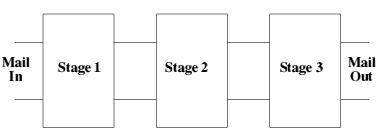 In
a mail sorting office the letters to be sorted often come in as a batch,
and it is important to organise workers in the way that will get all the
post sorted as quickly as possible. Many post companies used to move
the bulk of their workers along with the mail, i.e. all workers were
initially made to help at the start of the sorting line, to reduce the
backlog, and then were gradually moved along the sorting line, as the backlog
moved along it. However Queueing Theory can be used to see if this
is indeed the quickest way to sort mail, or to suggest the quickest way,
if this isn't it.
In
a mail sorting office the letters to be sorted often come in as a batch,
and it is important to organise workers in the way that will get all the
post sorted as quickly as possible. Many post companies used to move
the bulk of their workers along with the mail, i.e. all workers were
initially made to help at the start of the sorting line, to reduce the
backlog, and then were gradually moved along the sorting line, as the backlog
moved along it. However Queueing Theory can be used to see if this
is indeed the quickest way to sort mail, or to suggest the quickest way,
if this isn't it.
| Symbol | Represents |
| n | Number of stages (the stages are numbered from 1 to n) |
| Ak(t) | Cumulative number of letters that have arrived at the stage number k |
| Dks(t) | Cumulative number of letters that have departed from stage number k, into the input queues of the next server |
| Dkq(t) | Cumulative number of letters that have departed the queue for stage number k |
| Dk(t) | Cumulative number of letters that have departed from stage number k, this is equivalent to Dkq(t), as all letters that go into a server must also leave the server, and by our assumptions letters spend a negligible time in the server. |
| The service rate for all servers combined | |
| The service rate for the kth stage |

![]() .
.
The acheive either a. or b. we wish to maximise Dn(t), hence:
Hence all the stages should have the highest possible service rate,
which is thus ![]() /n,
this would yield the highest Dk(t) for all k.
/n,
this would yield the highest Dk(t) for all k.
It is never good to have a ![]() (k-1)>
(k-1)> ![]() k,
as this will create a queue between stages k-1 and k, and the excess service
rate used to create the queue could have been better used at the next stage
to avoid the queue forming in the first place.
k,
as this will create a queue between stages k-1 and k, and the excess service
rate used to create the queue could have been better used at the next stage
to avoid the queue forming in the first place.